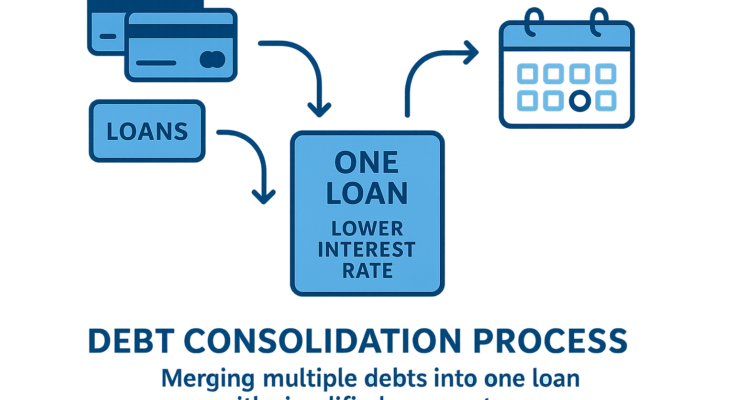Debt Consolidation Decoded: Simplify Your Finances and Save
Debt consolidation is like merging a chaotic pile of puzzle pieces into one clear picture. It combines multiple debts—credit cards, personal loans, car payments—into a single new loan, often with a lower interest rate, simpler monthly payments, and a more manageable timeline. The goal? To turn financial chaos into clarity, reduce stress, and save money.
When Should You Consider Debt Consolidation?
- High-Interest Debts: Juggling multiple loans or credit cards with steep interest rates? Consolidation can slash what you pay in interest.
- Payment Overload: Struggling to track due dates for various debts? One payment means fewer missed deadlines.
- Interest Eating Your Income: If loan interest consumes a chunk of your paycheck, consolidation frees up cash flow.
- Strong Credit Score: A good credit history unlocks better rates, making consolidation a smarter move.
How Does Debt Consolidation Work? A Step-by-Step Guide
- List Your Debts: Gather all current debts—credit cards, car loans, personal loans—and note their balances, interest rates, and monthly payments.
- Crunch the Numbers: Calculate the total owed and compare it to what a consolidated loan might cost.
- Apply for a New Loan: Secure a consolidation loan with a lower interest rate, ideally from a bank or credit union.
- Pay Off Old Debts: Use the new loan to wipe out existing balances.
- Stick to One Payment: Focus on repaying the consolidated loan with a single, simplified monthly installment.
Real-Life Example: From Chaos to Control
Imagine you’re managing:
- Credit Card: 8,000 SAR at 18% (800 SAR/month)
- Car Loan: 12,000 SAR at 10% (900 SAR/month)
- Personal Loan: 10,000 SAR at 12% (1,000 SAR/month)
Total Monthly Payments: 2,700 SAR
After consolidating into a 30,000 SAR loan at 8% over 5 years:
- New Monthly Payment: ~1,800 SAR
- Monthly Savings: 900 SAR
- Simplified Tracking: One due date, one payment.
Proceed with Caution: Potential Pitfalls
- Long-Term Costs: Extending repayment might mean paying more interest over time.
- Hidden Fees: Some lenders charge origination fees or penalties for early repayment of old debts.
- Credit Score Risks: If your credit isn’t strong, you might not qualify for better rates.
Key Takeaways
- Compare Rates: Ensure the new loan’s interest rate is lower than your current average.
- Check Eligibility: Use free credit score tools to gauge your chances before applying.
- Change Habits: Consolidation isn’t a magic fix—avoid racking up new debt once you’ve streamlined the old.



Hey very nice site!! Man .. Beautiful .. Amazing .. I will bookmark your website and take the feeds also厈I am happy to find a lot of useful info here in the post, we need develop more strategies in this regard, thanks for sharing. . . . . .